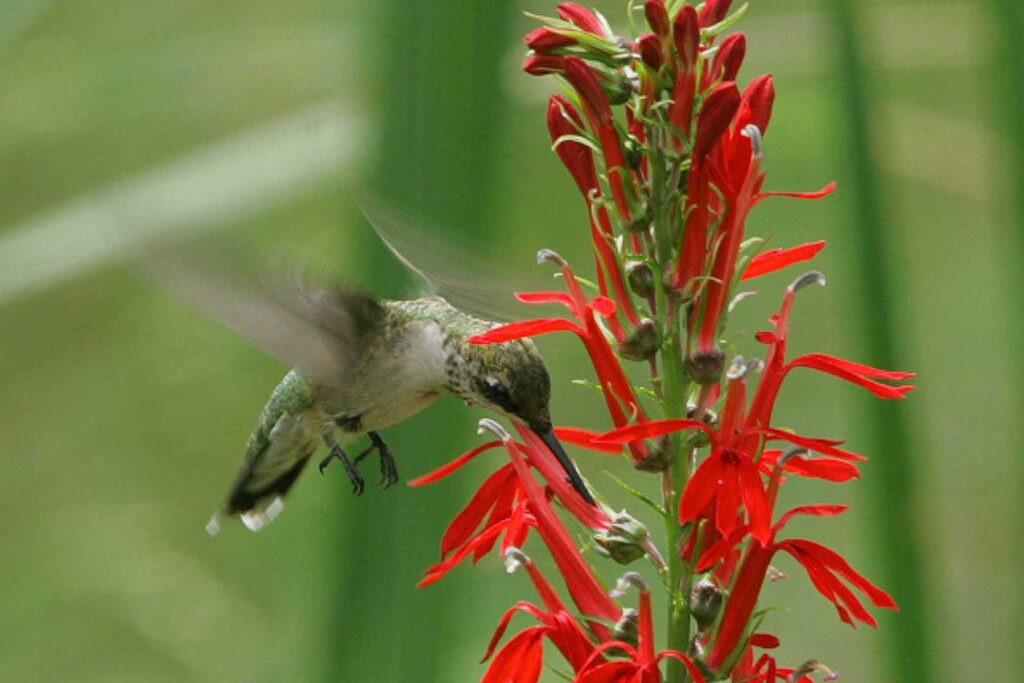The plants and animals we see today have danced an elaborate waltz for hundreds and thousands of years.
Over time, plants and wildlife in a region co-evolve, adapting to each other’s behavior and needs. It’s a tug-o-war over survival that ultimately benefits them both.
When plants and their pollinator change their very structure and behavior to take advantage of one another, it is called specialization. There are benefits to a specialized partnership.
From a plant’s point of view, attracting a specific pollinator means reliable movement of pollen within its species. Let’s say a hummingbird is visiting a red, trumpet-shaped Cardinal flower. As the hummingbird sticks their long tongue into the flower to lap sweet nectar at the bottom, pollen brushes its face. When the hummingbird moves to a different plant for more nectar, it will pick a red flower that will fit its pollen-dusted face, likely another Cardinal flower. Because of shape specialization for long-tongued pollinators, the Cardinal flower will not accidentally get pollen from another species, like a daisy or aster which both have flat flowers.
From a pollinator’s perspective, plants with features that cater to their body reduce competition. Bees and beetles will not bother with the long tube-shaped flowers hummingbirds love. There are easier food sources their short tongues can reach.
But there are downsides to specializing. What if a pollinator’s population decreases? Maybe too many artificial lights have confused moths and made them easy pickings for predators. Other pollinators may not have the right body shape or color recognition to visit the plant. No pollination, no reproduction, no new generation of plants.
Additionally, it is risky for a pollinator to adapt an entire body shape and behavior pattern to a single plant. What if the plants have a year where blooms are spaced further apart? Perhaps some innocent hiking group created a new trail and trampled a large swath of plants. It is energy-consuming to fly or crawl long distances.
While it is ultimately a partnership, these mutual adaptations did not happen over a casual conversation. Rather, it starts with plants’ methods and tricks to defend themselves from predators. For example, African Acacia trees have 3-inch long thorns to ward off plant-eaters from stripping leaves. Closer to home, Common Milkweed has a chemical within the leaf that makes it toxic to nearly all leaf-eaters.
As much as plants weaponize, animals meet the challenge. In the former example, a giraffe has a thick, 20-inch prehensile tongue that can scape a branch clean. Thorns are not a problem. With the latter, Monarch butterfly caterpillars can process the toxin. It even helps them later in life.
The idea that plants and animals co-evolved with special physical adaptations is not new. The story goes that Charles Darwin was sent a flower now known as Madagascan Star Orchid (Angraecum sesquipedale) in 1862. He predicted that the narrow tube created by petals must need an insect with a very long tongue to reach the nectar at the bottom. As with his Theory of Evolution, many scientists vehemently disagreed and he was ridiculed for the idea.
Some specialization is extreme. In the Sonoran Desert in the Southwest, the Senita cactus depends on a single animal, the Sentia moth. The moth is its only pollinator. But the moth depends equally on the caucus for food in a water-starved landscape.
Extreme specialization is the vast minority. We see moderate types of specialization every day. For example, bees see ultraviolet. Violet-colored flowers glow brightly with attractive light more so than red flowers. For purple plants, bees are primary pollinators.
If you want to attract certain pollinators to your yard or garden, your best bet is to plant their specialized partners. Since 2021, Red-tail Land Conservancy offers free one-on-one mentorship and a downloadable guide on how to transform yards and gardens into an oasis for beneficial wildlife as part of their Growing Home™ program.
Growing Home™ is a backyard habitat certification program driven by a community-centered conservation movement. To download the wildlife-friendly landscaping guide, ask for advice, or submit a certification application for your yard or garden, visit www.fortheland.org/growinghome. Certification applications are due July 31.
Kelley V. Phillips is the Communications & Outreach Manager for Red-tail Land Conservancy. She strives to cultivate wonder in nature and action to protect it.




